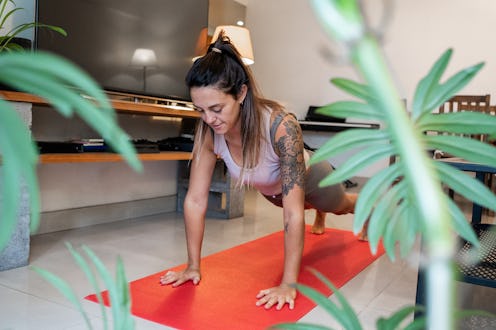Viral
Do You Really Need To Be Able To Do 11 Push-Ups? TikTok Says Yes
You can thank Mel Robbins.

One of the sounds echoing around #FitTok right now comes from Mel Robbins’ podcast. On March 3, the motivational expert and author was interviewing Dr. Vonda Wright, an orthopedic sports surgeon and longevity expert, when the topic rolled around to workouts.
According to Wright, everyone should be able to do at least 11 push-ups. “Learn to lift your own body weight,” she said in the clip. “Every woman should be able to do 11 push-ups. Regular push-ups.” Robbins chimed in to ask, “On the knees OK?” referring to modified push-ups, and Wright was quick to say “no.”
The sound is now going viral on TikTok as people pop down to the ground to see if they can do 11 push-ups — and it’s more difficult than it might seem. Creator @tia.prh got in a position to do one and immediately flopped on the floor. “On a good day I can do six, max,” she said in her caption.
Many people joked about not being able to do any, but others did 11 with no problem, like creators @graceegrove and @endurancegrand, who said she could only do two when she first started exercising. The trend has everyone wondering how to get better at push-ups and why they’re so important. Here’s what to know.
Why Push-Ups Are Important
According to Deb Simpson, CPT, a certified personal trainer and founder of Empowering Athena, push-ups are one of the best full-body exercises you can do.
“[The move is not just about your] chest and arms — it’s managing your core control, maintaining shoulder stability, and even working on mobility through the movement,” she tells Bustle. As you lower down and push back up, you engage multiple major muscle groups and joints, making it a worthy addition to your workout routine.
As a weight-bearing exercise, push-ups also help build your bone density, which is important as you age to maintain strength. It’s also a movement that can help you get up off the floor. That may not sound like a big deal when you’re younger, but it’s a skill you’ll want to maintain as you get older.
“I’ve had clients in their 40s, 50s, and 60s hit their first full push-up, and you can see the shift in confidence,” says Simpson. “It represents more than just physical strength. Being able to push yourself off the ground, support your bodyweight, and move through life with control — that’s independence.”
Along with the 11 push-up recommendation on Robbins’ podcast, Wright also said it’s important to lift heavy a minimum of twice a week. Since heaviness is subjective, that means a weight you can lift four to six times before you need a break — a good gauge to keep in mind when choosing one at the gym. She also said to walk at a brisk pace three hours per week, which you can break up into 45-minute sessions.
If you can’t do a push-up, that’s OK, too. Try a deadlift or look for other ways to add weight training into your life that are a better fit for your body.
Why 11 Push-Ups?
If you’re wondering why 11, there’s no special reason it’s become the golden number for this trend, other than it sounds catchy. “Ten is a round number, but 11 feels like you’re going beyond the basic goal,” says Simpson. “It’s that little bit extra that you have to push for.”
Meanwhile, according to the Mayo Clinic, for women in their mid-20s, the goal should be 20 push-ups, while women in their mid-30s should aim for 19.
How To Do A Push-Up
A push-up is more than just bending your arms and lowering yourself to the ground or pushing yourself up and down in quick succession. To make the most of the move, you’ll want to use proper form — and avoid common mistakes like flaring your elbows or raising your butt.
- Start in a high plank position with your shoulders over your wrists.
- Step your feet a little wider than hip-width apart.
- Keep your elbows tucked in at your sides.
- Engage your core and keep your body straight.
- Lower yourself down with control.
- Stop when your chest is just above the floor.
- Push into your palms to raise back up.
- That movement is 1 rep.
How To Do More Push-Ups
If you want to try the push-up challenge but can’t even manage one, stand up and do an incline push-up instead. “That means hands on a sturdy surface like a plyometrics box, bench, or countertop,” says Simpson. “That lets you train the right movement while keeping the load at a manageable level.”
Simpson recommends doing two to three sets of six to 10 reps a few times a week and gradually lowering the height of your incline over time. You can also add other core-strengthening moves like planks, which will help make push-ups easier.
“I’ve had beginners go from zero to 11 push-ups in about six weeks, but others take longer depending on their training history, injuries, or consistency,” says Simpson. If you want to get better at push-ups, it’s all about sticking with it and meeting yourself where you are.
Source:
Deb Simpson, CPT, certified persona trainer, founder of Empowering Athena